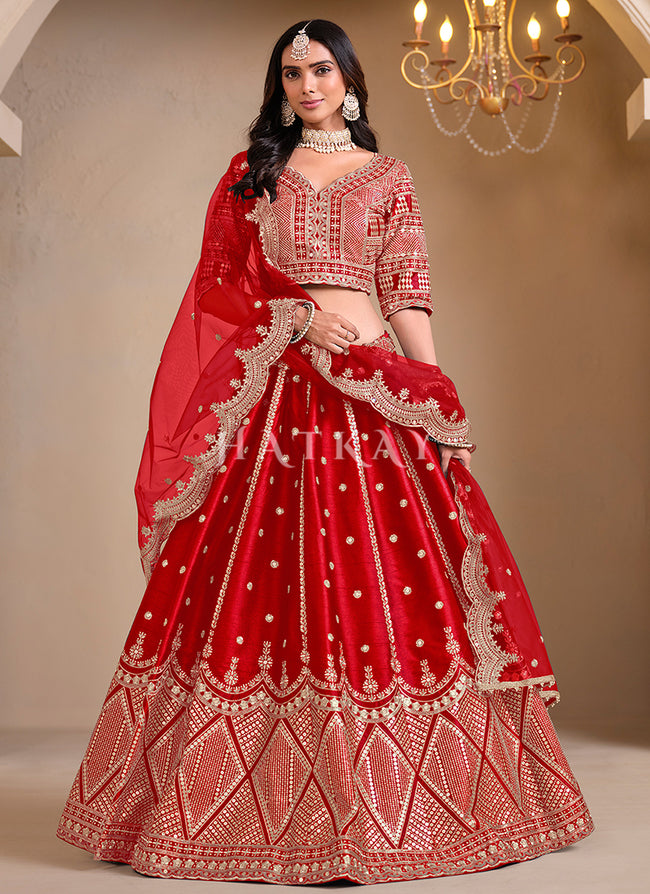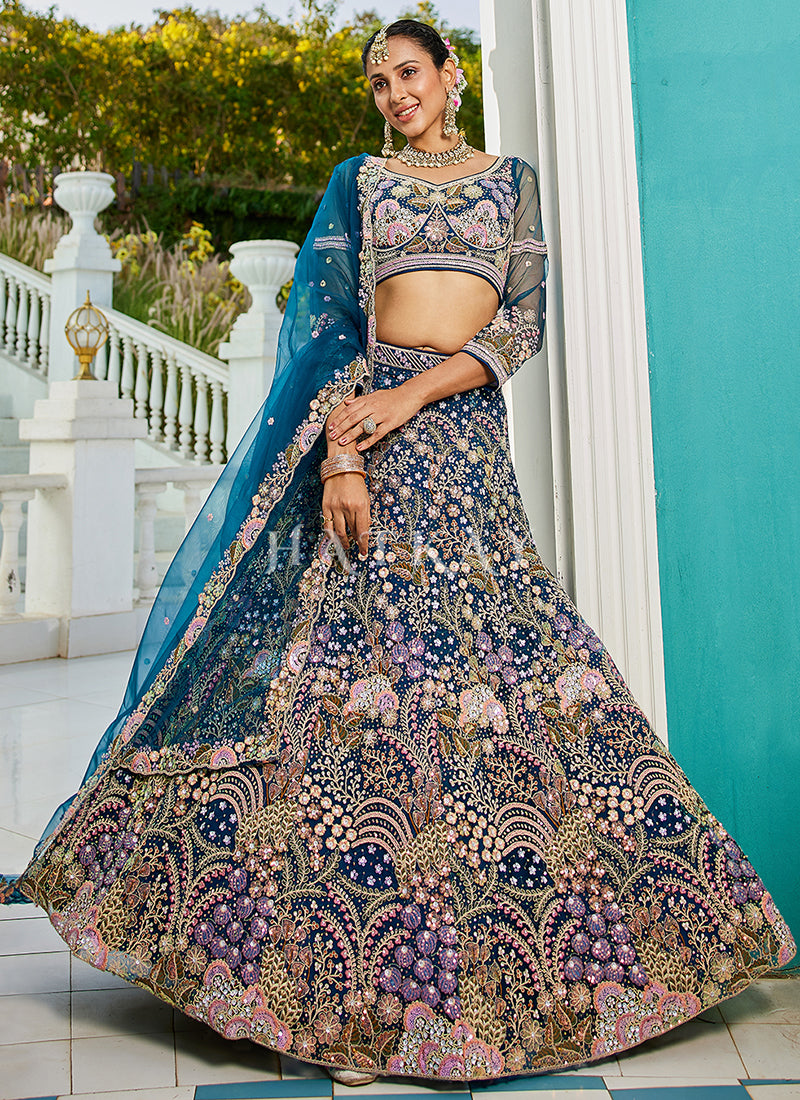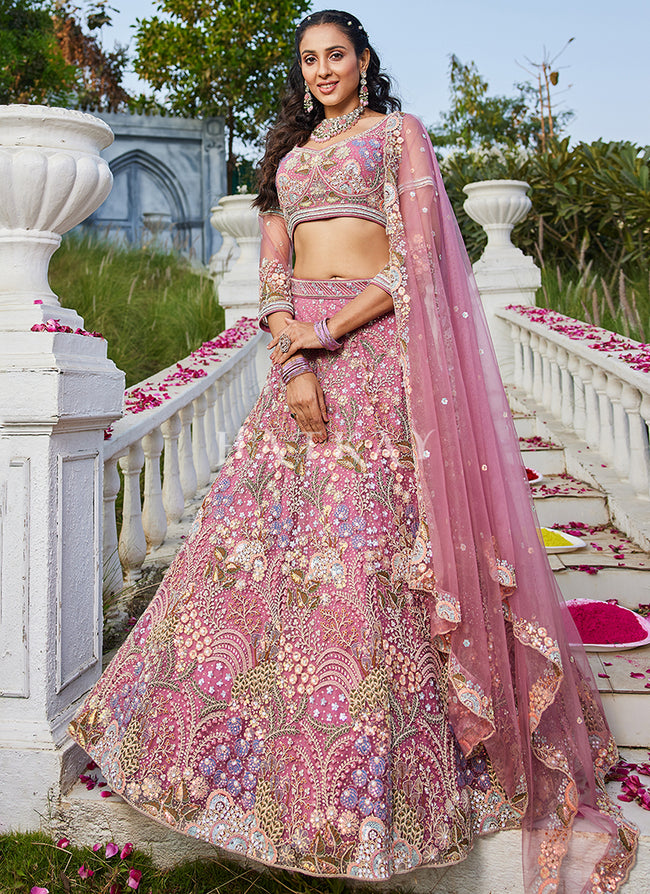Weddings are one of the most significant milestones in a person's life, particularly in cultures that place a strong emphasis on traditional attire and customs. Among these traditions, the bridal lehenga holds a special place in Indian weddings. A bridal lehenga is more than just an outfit; it is a symbol of heritage, elegance, and the start of a new chapter. From the intricate designs to the luxurious fabrics, wedding lehengas are a testament to the beauty and craftsmanship that define Indian bridal fashion.
This blog post will delve deep into the world of wedding lehengas, exploring their history, modern trends, how to choose the perfect lehenga for your wedding, and much more.
The History of the Wedding Lehenga
The lehenga, a traditional outfit consisting of a skirt, blouse, and dupatta, traces its origins to the Mughal era in India. It is believed that the Mughal emperors brought the concept of lehengas to India in the 16th century. Initially worn by royal women and aristocrats, the lehenga quickly became popular among the general populace, especially in North India, where it continues to be the preferred choice for brides.
The design of the lehenga has evolved over the centuries, with influences from various dynasties and cultures, making it a blend of regal and cultural artistry. During the British colonial period, the lehenga underwent significant transformations. It moved away from its traditional royal roots and became a more contemporary garment, often worn for festive occasions.
Today, the lehenga has cemented its place as one of the most essential components of an Indian wedding ensemble. It has undergone many changes, from simple designs to grand, intricate pieces, but its essence remains intact—a symbol of beauty, grace, and femininity.
The Different Types of Wedding Lehengas
Wedding lehengas come in a wide array of styles, designs, and fabrics. Each design caters to different tastes and preferences, making it easy for every bride to find a lehenga that suits her personality and style. Some of the most popular types of lehengas include:
1. A-Line Lehenga
The A-line lehenga is one of the most universally flattering styles. This design features a fitted waist that gradually flares out, resembling the letter "A," which creates a slimming effect. Brides who prefer a more classic and timeless look often opt for an A-line lehenga, which offers both comfort and elegance. It is suitable for almost all body types and is often chosen for daytime weddings or ceremonies.
2. Mermaid Lehenga
For brides looking to make a bold statement, the mermaid lehenga is the perfect choice. This design hugs the body closely up to the knees, before flaring out into a dramatic, floor-length flare. The mermaid style accentuates the bride’s curves and is ideal for evening or destination weddings. While it exudes a sense of sensuality and confidence, it requires a bit more consideration for comfort due to its form-fitting nature.
3. Flared Lehenga
Flared lehengas feature a voluminous skirt that creates a beautiful, flowing silhouette. The skirt has plenty of layers or pleats, giving it a majestic and full-bodied appearance. This design is often chosen by brides who want to look regal and grand. Flared lehengas are perfect for brides who want a more traditional, royal-inspired look.
4. Sharara Lehenga
A sharara lehenga is a stylish combination of a traditional lehenga and a pair of wide-legged pants. The sharara features a high-waisted, flared pant that is paired with a long, flowing top or blouse. This design has roots in Mughal fashion and is often chosen by brides looking for a more contemporary and chic wedding look. The sharara lehenga is ideal for those who want a unique twist on the traditional bridal lehenga.
5. Anarkali Lehenga
An Anarkali lehenga combines the elegance of the Anarkali suit with the flare of a lehenga skirt. The top is typically a long, fitted kurta that flares out, paired with a voluminous lehenga. This style is perfect for brides who want to create a more dramatic, regal look while still maintaining the traditional feel of the lehenga. The Anarkali lehenga is often adorned with intricate embroidery and embellishments, making it a favorite for grand weddings.
Choosing the Perfect Wedding Lehenga
Choosing the right wedding lehenga is no easy task. With so many styles, fabrics, colors, and designs to choose from, it can quickly become overwhelming. However, the process can be simplified by keeping a few important factors in mind.
1. Consider Your Body Type
The first step in selecting the perfect lehenga is understanding your body type. Different lehenga styles are better suited to certain body shapes. For example, a mermaid lehenga looks stunning on brides with hourglass figures, while an A-line lehenga is great for pear-shaped women as it balances proportions.
2. Fabric Matters
The fabric of your lehenga plays a crucial role in determining its comfort and overall look. Some popular fabrics for wedding lehengas include:
-
Silk: Known for its luxurious texture and sheen, silk is often chosen for grand, traditional weddings.
-
Satin: Satin lehengas are soft, glossy, and comfortable, making them ideal for evening weddings.
-
Georgette: A lightweight and flowing fabric, georgette lehengas are perfect for destination weddings.
-
Velvet: Velvet is a rich, opulent fabric often used for winter weddings, offering a regal touch.
-
Net: Net lehengas are perfect for brides who want to show off intricate embroidery or beadwork, creating a stunning contrast with the sheer fabric.
3. Color Selection
When it comes to bridal lehengas, color plays an essential role in setting the tone for the entire wedding. While traditional colors like red, maroon, and gold remain popular, modern brides are also opting for a wide range of hues like pink, teal, lavender, and even white. The color of your lehenga should complement your skin tone and align with the theme of your wedding.
-
Red: Symbolizing love, passion, and good fortune, red is the quintessential bridal color in many Indian weddings.
-
Gold and Silver: These regal shades are often chosen for their elegance and the luxurious aura they impart.
-
Pastels: Soft shades like blush pink, powder blue, and mint green are becoming increasingly popular for modern brides, offering a light and delicate appearance.
-
White: While white is traditionally worn in Western weddings, many Indian brides are now choosing white or off-white lehengas for their unique and contemporary appeal.
4. Work and Embellishments
The intricate embroidery and embellishments on a lehenga define its overall charm. Whether it's the resplendent zardozi work, sequins, or beadwork, each form of embellishment adds a unique character to the lehenga. Popular works include:
-
Zardozi: A luxurious form of embroidery using gold and silver threads.
-
Chikankari: A delicate form of hand-embroidery originating from Lucknow.
-
Mirror Work: Mirrors are sewn onto the fabric to create a shimmering effect.
-
Stonework and Beads: Adding stones and beads creates a dazzling effect that catches the light beautifully.
5. Comfort and Fit
While style is important, comfort is equally crucial. Your wedding day will be long, so it's essential to choose a lehenga that fits well and is comfortable enough for you to move freely. Pay attention to the fit of the blouse and lehenga, ensuring that you feel at ease while walking, dancing, and sitting during the ceremony.
Wedding Lehenga Trends in 2025
As fashion evolves, so do wedding lehenga trends. In 2025, we can expect to see several exciting trends shaping the bridal fashion scene. These trends include:
1. Minimalism with a Modern Twist
While traditional lehengas with heavy embellishments remain popular, there's a noticeable shift toward minimalist lehengas that exude sophistication with subtle details like delicate embroidery or understated patterns. Modern brides are opting for sleek silhouettes and clean lines, focusing on quality over quantity.
2. Sustainable Fabrics
As sustainability continues to be a priority for many, eco-friendly wedding lehengas are gaining popularity. Brides are increasingly looking for sustainable fabrics like organic cotton, silk alternatives, and upcycled materials. These eco-conscious choices allow brides to wear a beautiful lehenga while reducing their environmental impact.
3. Customizations and Personalization
Personalized wedding lehengas are becoming a trend as brides seek to make their wedding day unique and special. Custom embroidery, monograms, or custom color schemes are increasingly being incorporated into bridal lehengas, allowing brides to express their individuality and personal style.
4. Contrasting Lehengas
Brides are embracing contrasting colors and dual-toned lehengas, which combine two or more shades in one outfit. The color contrast can create a striking visual effect and add a modern flair to the traditional bridal ensemble.
5. Fusion Lehengas
Another growing trend is fusion lehengas, where brides combine traditional Indian attire with contemporary or Western elements. Brides are pairing lehengas with trendy crop tops, jackets, and even pants, breaking away from the classic lehenga look while still retaining its elegance.
Conclusion
Wedding lehengas represent more than just a piece of clothing; they are a symbol of beauty, tradition, and the beginning of a new journey in a bride’s life. With so many styles, fabrics, colors, and customization options available, there’s a perfect lehenga for every bride. Whether you opt for a traditional red lehenga or a modern fusion piece, your wedding lehenga will undoubtedly make you feel like the most beautiful version of yourself on your special day.
So, as you plan your wedding, remember to choose a lehenga that makes you feel confident, radiant, and ready to step into a new chapter of your life with grace and style.













